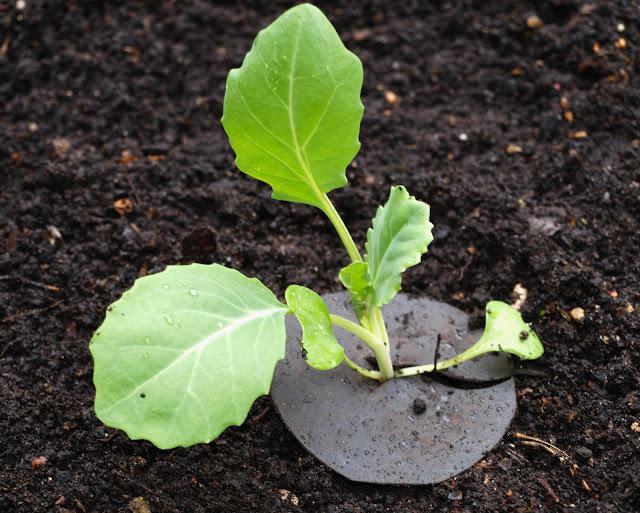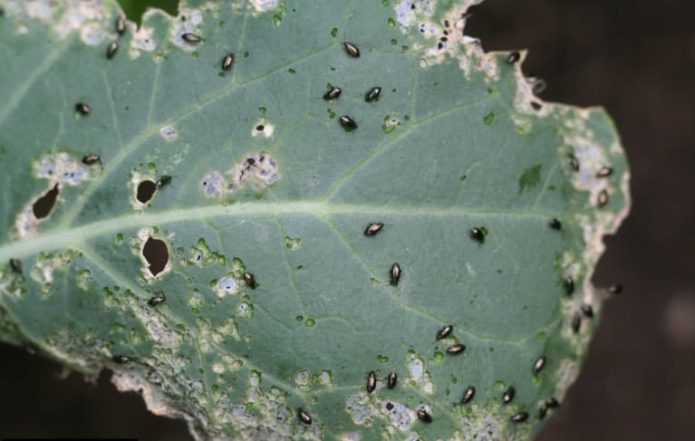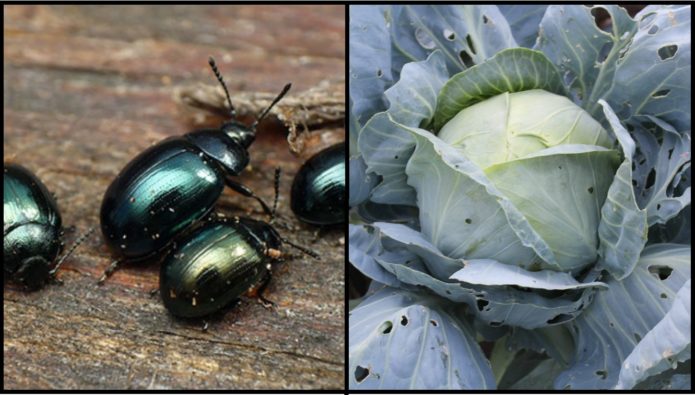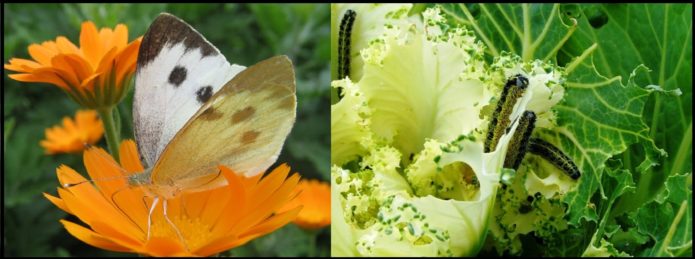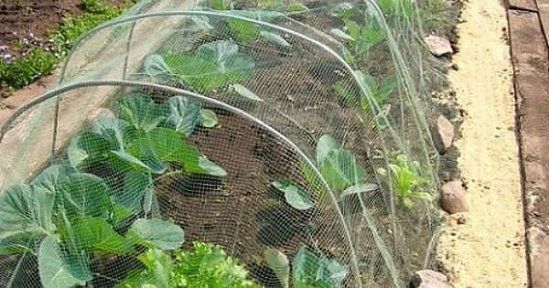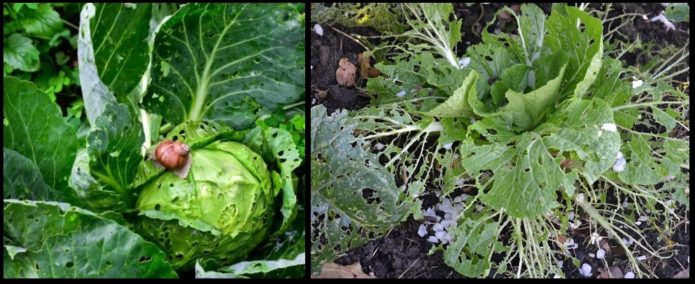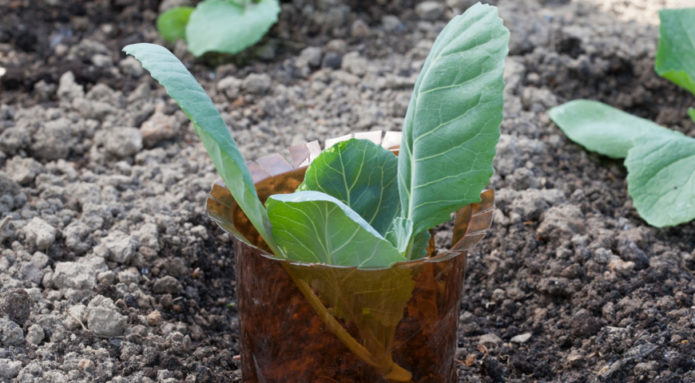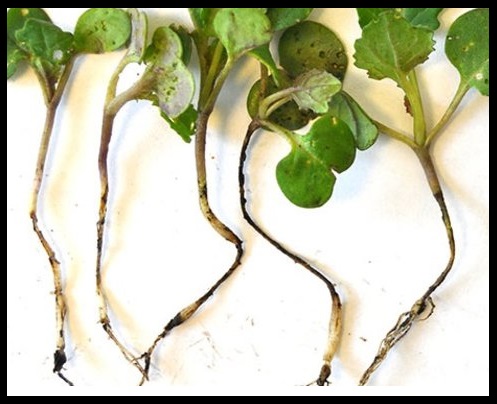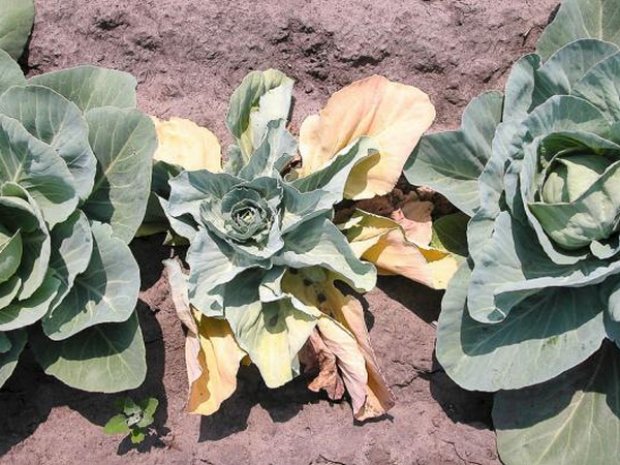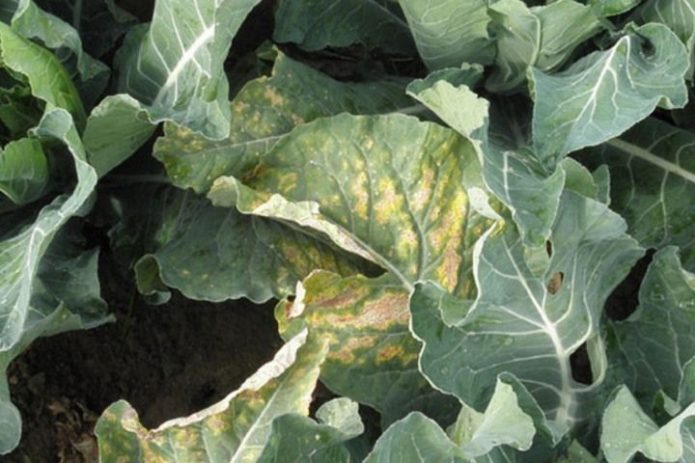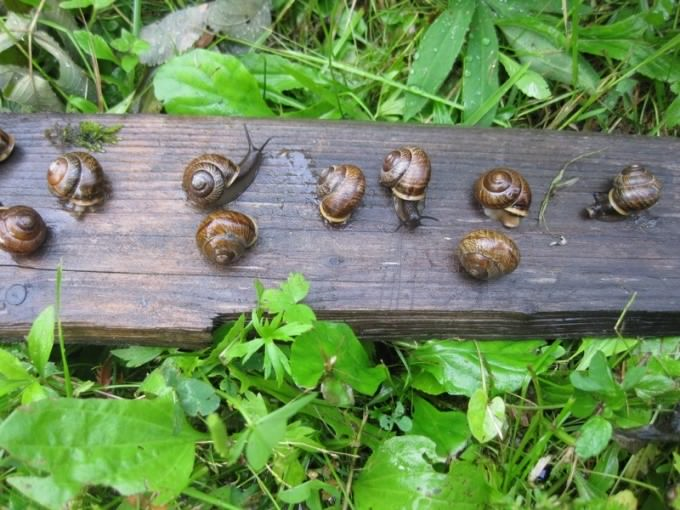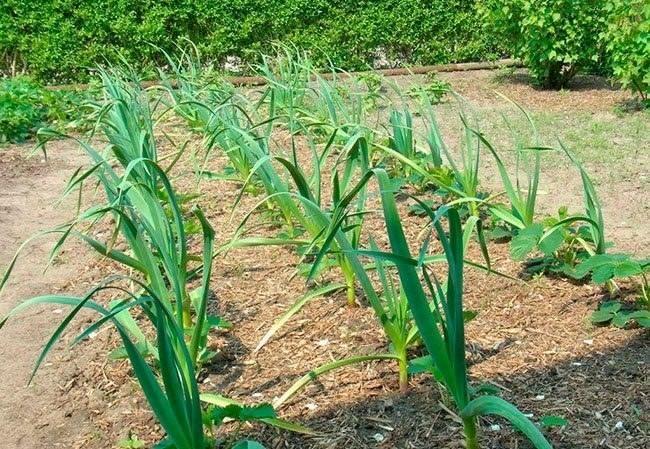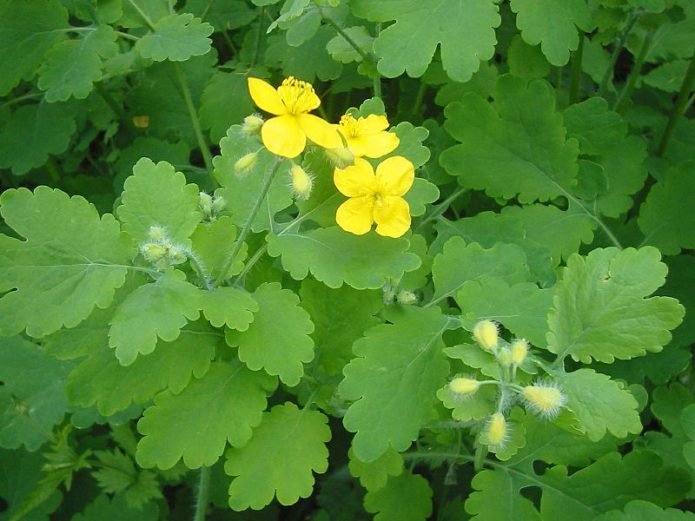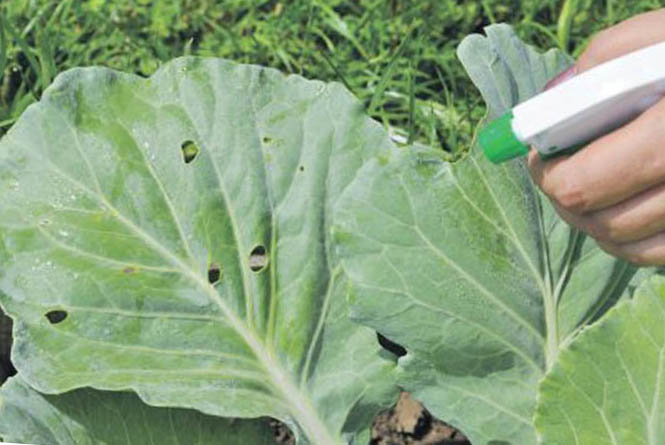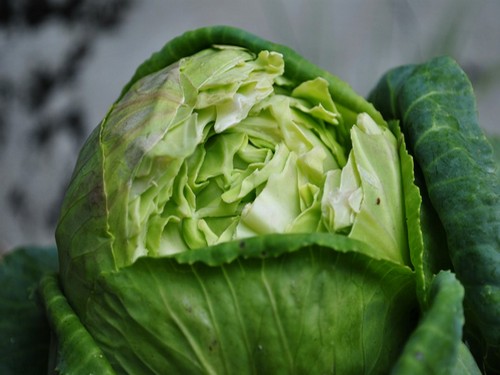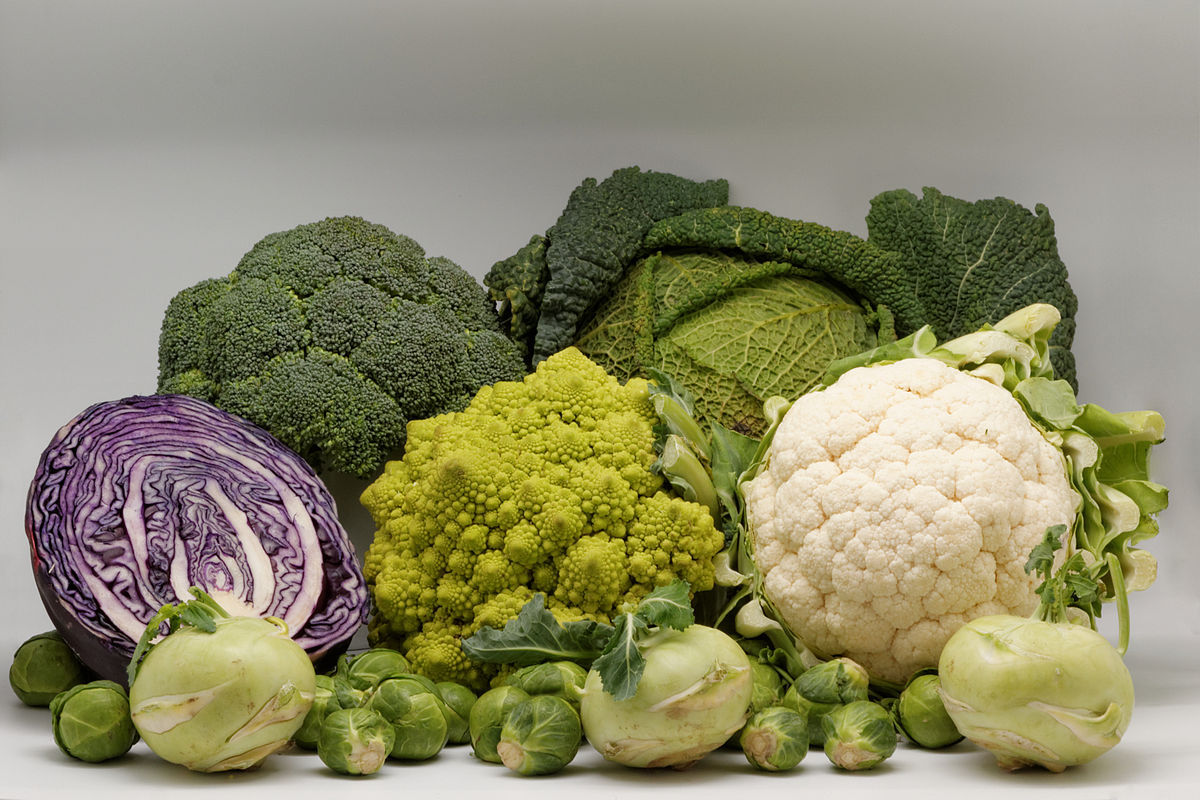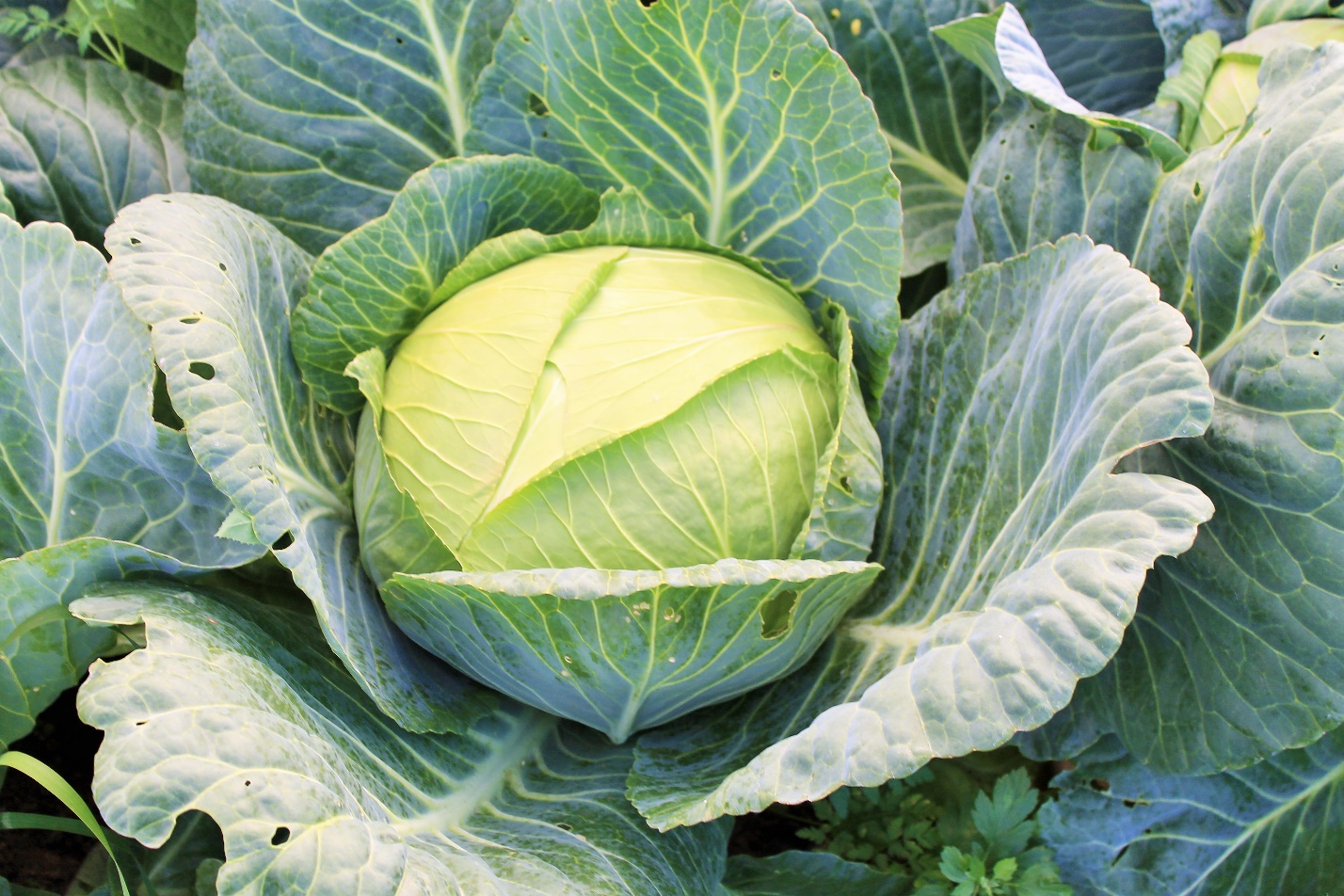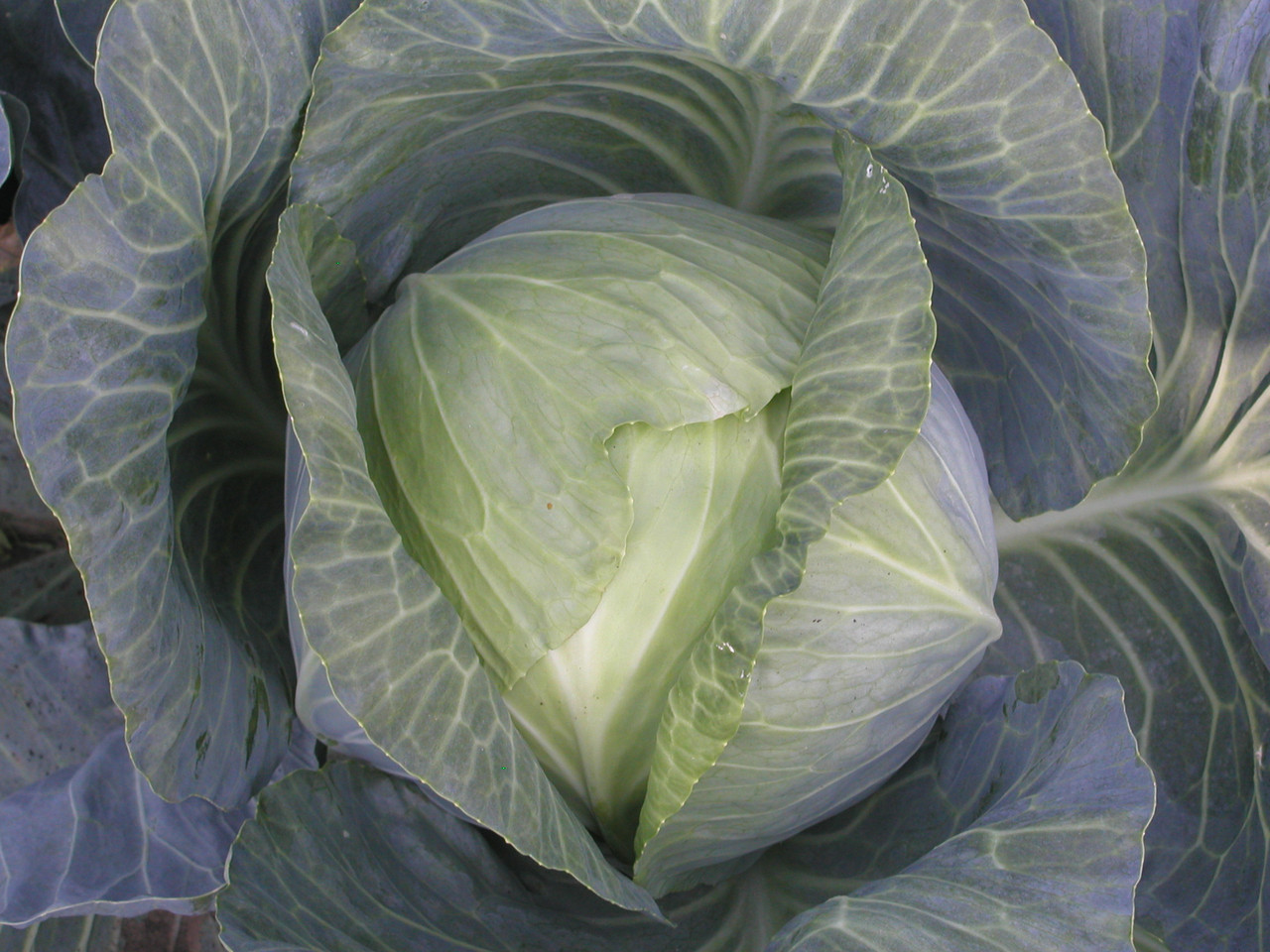Cabbage, edible and ornamental, is readily grown by amateur gardeners on their plots. Like any cultivated plant, it is susceptible to diseases and pests. We hope our tips will help you grow a healthy crop.
Content
General information about cabbage pest control and prevention of their appearance
There are many insects in the garden that can harm cabbage. Its juicy leaves are to the taste of caterpillars and bugs, slugs are capable of destroying a young head of cabbage in one night. There are many methods of dealing with them, but it is best to take preventive measures, then you will not have to destroy insects.
Phytoprotection
In the struggle for survival, the culture will be helped by other plants. By planting dill, fennel, carrots and celery on a bed with cabbage, we will not only scare away pests, but also attract other insects - their natural enemies.
Ornamental cabbage and edible cabbages can be successfully grown in a flower bed. Correctly selected plants will not only scare away harmful insects, but also give shelter to their enemies. For phytoprotection, we plant marigolds, marigolds, mint, coriander on the flowerbed. To attract insects that destroy pests, heaps of wood chips should be left between plantings, and umbrella plants should be planted in the beds.

Marigolds and marigolds, planted between the rows of cabbage, scare away pests - such plantings are called "phyto-protection"
Chemicals
Unfortunately, phytoprotection is not always effective. Other preventive and control measures should be used against a large number of insect pests.
Chemicals are used to protect cabbage. There are a large number of highly effective chemical protection products on the market, but their misuse can adversely affect the environment. On household plots, several drugs of a wide spectrum of action are used:
- Low-toxic biological product Fitoverm weakens the insect and it dies after a while. Early cabbage varieties are processed during the entire growing season, processing is stopped a week before harvesting;
- the preparations Inta-Vir, Decis and Iskra-M act on the pest instantly, they can be used to process cabbage of late varieties and cabbage of medium ripening.Plants are sprayed in dry weather in the morning or in the evening, stop using a month before eating cabbage.
It is not recommended to use one drug more than twice a season in order to prevent insects from getting used to it.
Cabbage pests: prevention and destruction
As already mentioned, cabbage has a great variety of pests:
- cabbage aphid,
- cabbage fly,
- cruciferous flea,
- cabbage leaf beetle,
- cabbage butterfly,
- slugs.
Let us consider in more detail what can be done when each of them is found on the heads of cabbage and how to prevent the appearance of pests on the cabbage bed.
Aphids attacked cabbage
The most common garden pest is cabbage aphid. This small insect, about two millimeters in size, feeds on the sap of the plant, sucking on it with its proboscis. Cabbage aphids are attracted by tender cabbage seedlings. The plant deprived of juices weakens and may die.
Due to the special metabolism, the cabbage aphid, unlike the usual one, contains a substance that is a deadly poison for its natural enemy, the ladybug.
Preventive measures:
- at the end of the season, remove cabbage stumps and leaves from the beds;
- if there are anthills near the cabbage ridge, destroy them: ants "graze" aphids, feeding on secretions from its abdomen;
- sow carrots between cabbage, the smell of its tops does not like aphids.
Destruction of the pest:
- heavy rain - pour cold water on the plant, it should wash off the pest;
- Fitoverm preparation: dissolve 4 ml in 1 liter of water and spray the plant. We carry out repeated processing in a week;
- Iskra-M preparations (10 ml + 10 l of water) and Inta-Vir (1 tablet + 1 l of water) help to quickly cope with the pest; processing is carried out with an interval of 2 weeks.
How to escape a cabbage fly
The offspring of this small fly can destroy the entire crop. The fly makes its first flight when the dandelion blooms and catkins appear on the birch. She begins to lay eggs when flowers appear on the cherry. Expect a massive bloom of spring flies as soon as the lilac begins to bloom. A summer fly will appear in mid-June if the air warms up to 18 ° C.
The cabbage fly does not fly in rainy weather.
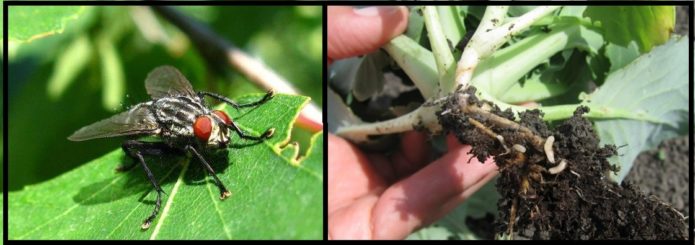
Cabbage fly larvae damage the root, a diseased plant can be easily identified by its sluggish appearance
The fly can lay up to one and a half hundred eggs, the larvae will appear in a week. The eggs are attached directly to the plant or in the topsoil. In carrying out preventive measures, we pursue two goals: to prevent the fly from laying eggs on the cabbage and, if this does happen, to prevent the larvae from reaching the roots. If the larvae have penetrated the root system, the plant will inevitably die.
Preventive measures:
- we do not plant cabbage for two years in a row in one place;
- in the fall we dig deeply into the soil to a depth of 30 cm;
- after planting seedlings, cover the ground in the root part with a piece of roofing material or linoleum;
- we cover a bed with cabbage with thin spunbond for the period of the fly's flight (density 17 g / sq. m);
- we loosen the soil 2 times a week to a depth of 2-3 cm - this makes it difficult for the larvae to access the roots.
To destroy the pest before planting seedlings in the soil, we introduce insecticide Zemlin at the rate of 3-5 g per 1 sq. m. The preparation is mixed with sand. The larvae, if they remain in the soil, will die in a day.
Cruciferous flea is the main enemy
Young cabbage leaves attract the cruciferous flea. A small hopping beetle about three millimeters long gnaws small holes in the leaf plate. The pest wakes up in early spring and becomes active in hot weather.
The beetles lay their eggs in the soil. The hatched larvae feed on cabbage roots, but the main harm is done by adults.
Preventive measures:
- we dig up the soil in the fall to a depth of 30 cm;
- before planting, we loosen the soil to a depth of 8–10 cm;
- after planting seedlings or emergence of seedlings, cover the beds with thin spunbond (density 17 g / 1 sq. m).
We destroy the pest:
- we spray the plant with Inta-Vir (1 tablet + 1 liter of water); if necessary, repeat the treatment after 2 weeks;
- we process the heads of cabbage with the drug Decis (0.5 g + 5 l), also with a repeat after 2 weeks.
Cabbage leaf beetle
A small shiny beetle, 5 mm long, leaves large holes in the cabbage leaves, eating away the flesh. The pest hibernates in the soil, waking up in early spring. The leaf beetle lays eggs in gnawed leaves; larvae, emerging after two weeks, continue to destroy the plant, eating the skin of the leaf.
Preventive measures:
- we dig up the soil in spring and autumn;
- we destroy weeds;
- we close the planting with a thin spunbond (density 17 g / 1 sq. m).
We destroy the pest:
- when beetles and larvae appear, spray the cabbage with Inta-Vir (1 tablet + 1 liter of water);
- we process the plantings with Decis (0.5 g + 5 l of water), repeating, if necessary, the treatment after 2 weeks.
Pest butterflies
By themselves, butterflies are harmless - they pollinate flowers and serve as food for small predators, frogs and dragonflies. Their caterpillars are dangerous. Pests of cabbage are caterpillars of the whiteworm butterfly and cabbage scoop.
The white butterfly, or cabbage, appears in early May and late July. During her short life, she is able to lay several hundred eggs.
The butterfly attaches the masonry to the underside of the leaf. Under favorable conditions, dozens of voracious caterpillars will be born in a week. Before pupating, they feed on cabbage leaves for two to four weeks, and during this time they can deprive the vegetable of its presentation. Caterpillars gnaw out a soft leaf plate, leaving only thick veins. Adults are capable of migrating and settling on other plants.
The white butterfly is also attracted by other cruciferous plants - rutabaga, horseradish. She also does not disdain nasturtium leaves.
Preventive measures:
- digging a vegetable garden in the fall on a shovel bayonet;
- in the spring we destroy all weeds in the garden;
- we plant seedlings early - before the appearance of butterflies.
Destruction:
- mechanically remove eggs and caterpillars during daily inspection;
- spray with Fitoverm (4 ml + 1 l of water);
- spray with Inta-Vir (1 tablet + 1 liter of water);
- we treat it with Iskra-M (10 ml + 10 l of water).
The cabbage scoop is a moth. It hatches from the pupa 2-3 times a year and lays eggs on the underside of the cabbage leaf. Medium and late ripening cabbage especially suffers from this pest. Caterpillars of the cabbage scoop are able to eat the core of cabbage seedlings.

The cabbage scoop is capable of laying up to a thousand eggs in its life, the caterpillars make moves in the head of cabbage and pollute them with their excrement
Caterpillars hibernate in the ground at a depth of 30 cm, and with the onset of spring they move to the upper, warmer layers of the soil.There they pupate at a depth of three to ten centimeters, and a month later a butterfly hatches.
Preventive measures:
- we loosen the ground in the aisles to a depth of 10 cm in autumn and spring;
- carefully weed out the weeds;
- we plant seedlings early, before the appearance of butterflies;
- close the planting with a fine mesh;
- do not plant other cruciferous crops nearby;
- we sow coriander in the fall next to the cabbage bed, in the spring it will bloom and disguise the cabbage with its pungent smell.
Destruction of the pest:
- mechanical removal of eggs and caterpillars (moth caterpillars are easier to detect at dusk, when they are activated);
- spraying with Fitoverm biological product (4 ml + 1 l of water);
- insecticide treatment Inta-Vir (1 tablet + 10 l of water), Iskra-M (10 ml + 10 l of water), Decis (0.5 g + 5 l of water).
Omnivorous slugs
Slugs and snails are happy to eat all kinds of cabbage. They feel especially at ease in damp weather, actively settling in cabbage beds. During the day, in hot weather, they hide under the leaves, and at night they gnaw holes in them.
Preventive measures:
- we surround the cabbage plantation with a strip of plowed land;
- we pull out the weeds;
- we surround each plant with a shallow furrow filled with husks from seeds, coarse sand, eggshells or nuts;
- remove shellfish from cabbage leaves daily;
- sprinkle the cabbage with superphosphate powder to scare away the snails.
A plastic fence placed around the young plant will not only protect it from slugs, but also prevent the scoop from laying eggs in the root area.
Destruction of the pest:
- a layer of lime poured near the plants will burn the abdomen of the mollusk and lead to its death;
- in case of a mass invasion of gastropods, the chemical preparation Thunderstorm will help. It is scattered on the garden bed, a 15 g package is enough for 20 square meters. m. The preparation contains a substance that kills slugs and snails.
Video: we destroy cabbage pests
Cabbage diseases
If the rules of agricultural technology are not followed in the process of growing cabbage, the plant may get sick. Viral and bacterial infections can cause serious damage to your crop.
Keela
This fungal disease affects the roots of cabbage. The plant looks lethargic, does not grow and may die.
Keel spores do well in an acidic environment. To avoid disease, we plant cabbage only in limed soil.
Preventive measures:
- a week before planting, we spill the earth with a 3% solution of Bordeaux liquid (10 liters of water + 10 tablespoons of the drug);
- put 1 tablespoon of ash in the landing hole;
- every 2-3 weeks we water the plant with milk of lime (10 l of water + 1 glass of dolomite flour); for one plant - 1 liter of solution.
Unfortunately, the keela cannot be cured. The diseased plant must be removed and cruciferous plants must not be planted in this place for four years.
Black leg of cabbage
Waterlogged soil and damp weather contribute to the development of this fungal disease. The fungus affects the seedlings in the root part. In young seedlings, this part of the stem rots and the seedling dies. An adult seedling may survive, but its stem will dry out and it will develop less well.
Preventive measures:
- do not allow waterlogging of the soil;
- lime the soil;
- before planting, we soak the seeds in a solution of the Fitosporin-M preparation according to the instructions;
- seedlings in the phase of 2-3 leaves are sprayed with a 2% solution of Fitosporin-M;
- periodically we spill the plants with a solution of colloidal sulfur (50 g of sulfur + 10 l of water).
Fragile young seedlings cannot be saved; they must be destroyed and the seeds sown again. Before sowing, the spilling of high concentration sulfur preparations (40 g of sulfur + 5 l of water) will help to destroy the fungus in the soil.
The vapors released by the sulfur stop the development of the fungus. The drug is practically safe, it does not penetrate into the plant. Sulfur is most effective at temperatures between 20 and 35 ° C.
White and gray rot
Fungal diseases white rot and gray rot, or botrix, usually affect cabbage heads if stored improperly. The fungus feels comfortable in conditions of high humidity and temperature.
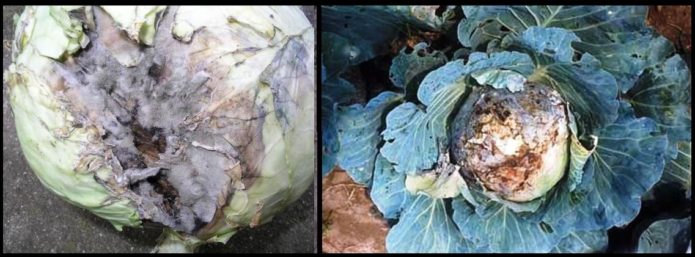
On the left is a head of cabbage affected by gray rot; white rot (head of cabbage on the right) can affect the plant in the garden
When affected by gray mold, fluffy mold appears on the leaves, the disease is accompanied by an unpleasant odor. With white rot, a white mycelium with black spores forms between the leaves, mucus is noticeable on the leaves. The infection spreads quickly and can destroy the entire crop.
Preventive measures:
- do not get carried away with nitrogen fertilizers;
- harvest the crop on time, preventing it from rotting in the beds;
- disinfect cabbage before placing cabbage in storage;
- store only healthy, undamaged heads of cabbage;
- when cutting a head of cabbage, leave a short stump and remove the lower leaves;
- keep a well-ventilated storage room at 95% humidity and 0–1 ° C;
- periodically check the condition of vegetables and remove diseased specimens.
The disease is not treatable. If possible, remove all affected leaves. Do not store the affected head of cabbage, it is better to put it into processing.
Cabbage mosaic
This viral disease manifests itself as a scattering of small black dots on cabbage leaves, and their lower side is more affected. The causative agent of the mosaic virus is carried by the cabbage aphid.
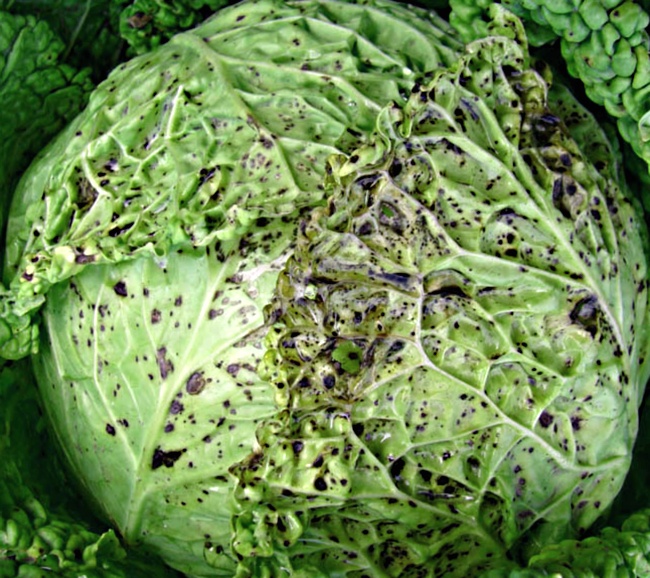
When the mosaic virus is infected, the veins of the leaf plate of the cabbage stop growing and the leaf shrivels
Prevention:
- remove weeds of the cruciferous family (shepherd's purse, rape, yarut and others);
- destroy cabbage aphids.
It will not be possible to cure a diseased plant. Affected heads of cabbage must be destroyed.
Fusarium wilting
Fusarium wilting (tracheomycosis, jaundice) causes yellowing of the leaves. This fungal disease can destroy the entire crop. Hot dry weather contributes to the development of tracheomycosis.
In a plant affected by a fungus, the leaves turn yellow, wither and fall off. The lower leaves are affected first, then the upper ones; the head of cabbage is not tied.
Preventive measures:
- we apply the rules of crop rotation;
- we process the soil before planting with copper sulfate (5 g of the preparation + 10 l of water).
Diseased plants must be dug up and burned, it is impossible to cure them.
Peronosporosis, or downy mildew
This fungal disease affects both young and mature plants. Seeds can be infected, the fungus is well preserved in acidic heavy soil.
First, the leaves turn yellow, then a gray bloom appears on them, containing spores. If the diseased plant is left untreated, the infection will quickly spread to all plants.
Preventive measures:
- we apply crop rotation;
- we process the seeds before sowing with a 1% solution of potassium permanganate, or we subject them to hydrothermal treatment:
- immerse in hot water (50 ° C) for 20 minutes;
- then cool in cold water for 2 minutes.
Treatment consists in spraying the affected plants with Bordeaux liquid (100 g of copper sulfate and 100 g of lime per 10 liters of water).
Video: how to deal with cabbage diseases
Traditional methods of prevention and control of cabbage pests
Over the years of the battle for the harvest, gardeners have tried a wide variety of pest control methods. Summarizing their experience, we provide some useful recommendations.
Dealing with slug and snail infestations
Harmful gastropods eat cabbage leaves, they can completely destroy seedlings. The following measures help to cope with the invasion of pests:
- collect snails - to lure them into one place, place halves of grapefruit and oranges (peel) near the beds, they will be filled overnight;
- we prepare places of rest for them (after a night feast, the gastropods prefer to rest in damp and coolness), laying out pieces of boards, roofing material, cardboard around the site; moisten the ground under them with water. We collect snails from time to time;
- We lure the clams with beer, for which we place cut-off bottles filled with beer around the area and release them as they fill up with snails. This is a somewhat costly way of fighting, a more budgetary option is to replace beer with fermented compote or kvass;
- to scare off pests, we spray the plants with herbal infusions (lavender, thyme, laurel, sage) or garlic infusion;
- judging by some reviews, strong coffee deprives snails of activity for a while. Prepare the solution at the rate of 2 teaspoons per 100 ml of water;
- we pour washing powder in the root area - the unprotected delicate abdomen of the gastropod does not tolerate contact with it;
- pour hot water over the cabbage (40–50 ° C), the snails die. This plant is able to withstand such a temperature, you should not experiment with others;
- if the summer is hot, black plastic bags will help reduce the clam population somewhat. In the evening we lay them out in the beds, in the morning the satiated snails will crawl under them. During the day, the hot sun will heat the bags and the hot condensation formed under them will destroy those who lurk there.
How to scare away butterflies
Butterflies are harmless by themselves, but they lay eggs from which hungry offspring hatch. In order to prevent insects from planting, they offer different methods:
- dummies of chicken eggs are placed on the beds. Presumably, having seen large white spots, the white butterfly should lose interest in these landings occupied by competitors. Dummies can be made of foam or use the shell of whole eggs, pouring gypsum into them;
- sweet baits are placed near the beds. A thick syrup is boiled from 12 teaspoons of sugar and a glass of water, poured into flat containers and dry yeast is added at the tip of a knife. The heady aroma of the fermented liquid attracts butterflies, and they get stuck in the syrup;
- marigolds and nasturtium are planted next to cabbage - the smell of these plants scares off pests.
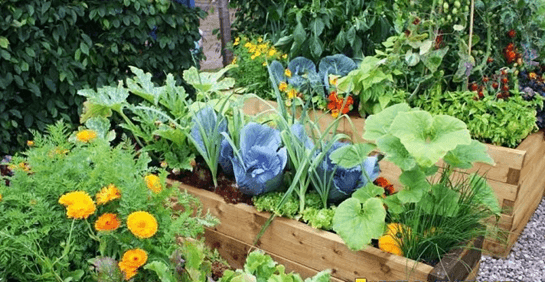
One of the ways to repel insect pests (for example, cabbage flies) is mixed planting with marigolds, nasturtium, and herbs.
Simple pest control
Simple home remedies found in the kitchen and medicine cabinet can help fight pests. They are used to prepare solutions or mixtures for dusting (dry pollination).
Table: Home Remedies for Cabbage Pests
| Means | Cooking method | Application |
| Vinegar | 10 liters of water + 1 glass of 9% vinegar | Spray cabbage with this solution - helps to scare away snails, cruciferous flea and cabbage fly |
| Ammonia | 10 l of water + 5 ml of ammonia | Watering a bush with a solution at the first sign of wilting - it has a detrimental effect on a cabbage fly |
| Salt | 10 l of water + 200 g of salt | Pour the solution under the root, it destroys the larvae of the cabbage fly |
| Bitter pepper | 100 g of fresh pepper or 50 g of dry raw materials + 1 liter of water to boil for an hour, then leave for 2 days; Dissolve half a liter of the finished infusion in 10 liters of water | Spray the soil and plant with a solution - helps to get rid of many cabbage pests |
| Spice |
|
|
| Onion peel | 10 liters of warm water + 200 g of husks, leave for 4 days |
|
| Valerian | 10 l warm water + 40 ml (1 bottle) valerian tincture | Process seedlings to protect them from cabbage flies |
| Toothpaste | 10 liters of water + half a tube of mint paste. Stir the solution thoroughly, leave for 4 hours | Spray cabbage from the moment the seedlings are planted in the ground. This remedy is very much disliked by white butterflies. |
Garden plants
Infusions can be prepared from cultivated plants and weeds:
- Chop the tops of nightshades (potatoes and tomatoes), fill a bucket 1/3, fill with hot water. After insisting 2 days, we spray plants from aphids;
- chop nettle, fill 1/3 bucket, fill with hot water. We insist for 2 days and spray from aphids;
- We insist 3 liters of water + 100 g of bird droppings, 1 kg of wormwood + 3 liters of water we boil for 15 minutes. We mix the wormwood broth and organic fertilizer, bring the volume to 10 liters. We spray cabbage from aphids;
- 200 g of yarrow + 2 liters of boiling water, we insist for 1 hour, then we dilute in 10 liters of water and spray it from aphids and caterpillars of white beetle and cabbage scoop;
- 1 glass of chopped celandine + 2 liters of boiling water we insist for 1 hour. For spraying from cabbage flies and aphids, we dilute an infusion in 10 liters of water; you can also dust the cabbage with dried celandine powder.
Organic fertilizers added to the solution enhance its effect.
Spraying is carried out in the evening, the solution should fall on all parts of the cabbage leaf. For better adhesion, you need to add 2 tablespoons of grated laundry soap to the product and stir until completely dissolved. Spraying should be started immediately after planting seedlings in the ground and then prophylactically carried out this procedure every week.
Ash is not only fertilizer
Ash is an irreplaceable assistant in the struggle for the harvest. Burning wood and grass waste, the gardener will always have the necessary amount of this useful substance. The plant, sprinkled with ash, repels pests. If ash is mixed with tobacco dust, ground pepper and dry mustard in equal parts, the effect will be stronger. Sprinkle not only the plant, but also the soil around it.
Heads of cabbage sprayed with an ash solution (10 liters of water + 2 glasses of ash) also cease to attract insects.
The risk of disease of the cabbage with a keel is reduced if an alkalizing composition is used for irrigation (10 liters of water + 200 g of ash, leave for a day).
Video: pest control of cabbage using folk methods
A plant that is not weakened by pests will also successfully resist viral and fungal diseases.
Heads of cabbage burst
Often one has to deal with such an unpleasant phenomenon as cracking of heads. The crop is ripe, you can take it off, but the cabbage has lost its presentation.
A defect manifested in a violation of the integrity of the head of cabbage has nothing to do with diseases or pests of cabbage. Rather, it is caused by violations of the rules of care. Cabbage needs regular watering. If in the last stages of ripening it experiences a moisture deficit, this will serve as a signal for the plant to start preparing for wintering and to coarse the upper leaves. Subsequent heavy watering will cause rapid growth of the lower leaves, and the heads of cabbage will begin to crack. To keep them intact, you need to harvest on time.
To grow a good harvest of cabbage, you should purchase seeds of varieties that are resistant to diseases. Fighting pests and diseases will help the implementation of simple rules of agricultural technology - plant in suitable soil, water and fertilize correctly, observe crop rotation, remove weeds, and take protective measures on time. Don't forget about helper plants. If planted next to cabbage, they will help scare off pests and provide conditions for the normal development of the plant.

